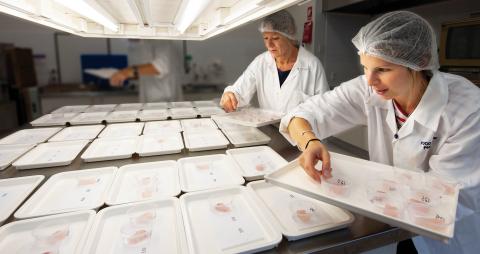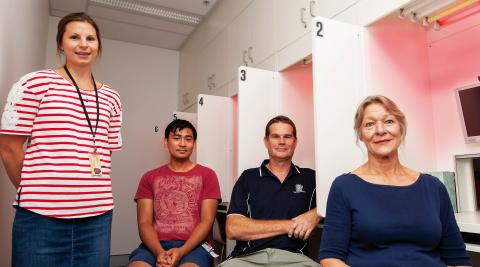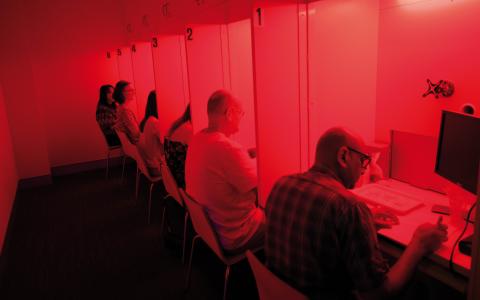When it comes to seafood, ‘fresh is best’ has been the mantra for eons. But is it? A fascinating food science project may lead to a challenging rethink of this belief
Story and photos Brad Collis

Sue Poole (left) and Philippa Tyler prepare randomised fish samples for one of the taste tests.
A research project that arose from questions put to consumers about why they do not buy seafood is throwing new light onto the fresh versus frozen debate, with some surprise early findings.
The issue has come to a head after a 2016 FRDC consumer survey revealed three key reasons for the aversion of non-seafood eaters – smell, uncertain freshness and lack of knowledge about preparation. All these issues could be resolved by supplying seafood as a ready-to-cook frozen product, but this runs head-on into perceptions that freezing seafood reduces its eating quality.
To test this perception, the FRDC commissioned the Queensland Department of Agriculture and Fisheries (DAF)’s seafood team, led by principal scientist Sue Poole. The team was asked to develop and run a series of ‘taste tests’ among both professional seafood chefs and consumer panels, to build a statistically valid position on whether fresh seafood really can be distinguished from the correctly frozen and thawed product.
The data is still being analysed. But if it shows that most people – including chefs with highly attuned palates – cannot pick the difference, then the results will not only confound conventional wisdom but have significant implications for supply chain management and product development.
Early observations from the research show trained palates can detect a difference in taste and texture between fresh and thawed product, but only after considerable discussion in a workshop scenario. This was an unexpected outcome for the chefs involved.
Sue Poole explains that the project was structured to collect data based on a sensory analysis of fresh and frozen fish. The species used in the tests were Barramundi, Spanish Mackerel, and farmed Cobia and groper. All were presented first as sashimi and then as cooked fish.
Triangle test

The DAF seafood team, from left, Phillipa Tyler, Carl Paulo, Paul Exley and Sue Poole.
The tastings were based on a sensory science method called the triangle test. Three samples are presented: two being the same (fresh or thawed) and one different (fresh or thawed). The samples are presented in multiple, random combinations, and tasters are asked to identify the sample that is different and to give a reason why – including stating if they are just guessing. If a significant number of people can accurately detect fresh versus frozen across the large number of random presentations, then the taste difference becomes scientifically quantifiable.
Sue Poole says the testing began with a focus group comprising four prominent seafood chefs in Brisbane. In the first session, fresh and thawed samples were presented side by side.
“The chefs believed the fresh flesh had slightly more sheen, which is what we expected,” she says. “But when it came to the actual tasting, they struggled to pick any difference. This surprised everyone because they all have keen palates. Eventually, as a group, they were able to correctly identify the fresh and frozen, but only after a lot of discussion.”
“When we presented the cooked samples, however, there was no consensus. Everyone struggled, and everyone admitted to struggling.”
Even with their agreement on the sashimi, Sue Poole says the chefs still made the point that while they did pick the difference, it still was not relevant to “the real world” because side-by-side comparisons are not made in a restaurant. “So they said they would not necessarily have been able to pick any difference if there was no immediate comparison being made,” she explains.
“In a subsequent discussion, all the chefs said access to properly frozen and thawed seafood would present advantages such as extending the seasonal availability of different species, reducing waste and allowing better stock management by fishers.” Following the focus group experiment, the DAF seafood team ran the same triangle test with tasting panels drawn from the general public.
The results of these tests are still being analysed.
Fresh or frozen: which is best?

Sue Poole, Principal Scientist, Department of Agriculture and Fisheries.
In the meantime, Sue Poole says the tests are already pointing to the need for more seafood education, including a better understanding of what is even meant by the word ‘fresh’.
“For us, it means a product that has been chilled. And no matter how close to capture this happens, the product will deteriorate over time yet still be labelled fresh.
“By contrast, fish that is frozen close to capture will retain that quality, so it can be argued that this is likely to provide a better eating experience … the qualifying elements being species and correct freezing and thawing.
“Freezing needs to happen very quickly. It must get from zero to past minus 3°C as fast as possible to avoid damaging ice crystals forming in the flesh. Once past minus 3°C, the commercial standard for frozen seafood is minus 30°C, although some companies are now freezing to minus 60°C and even minus 90°C.
“But this science is already done,” she says. “What we are now doing is accumulating accurate, reliable data on the impact of freezing on taste and texture for both sashimi products and cooked product.”
Sue Poole adds that the next step – if no statistically relevant taste differentiation between fresh and thawed is found – is to determine how long this quality state can be sustained. That is, how long can a fish product stay frozen before a more obvious difference does kick in?
“While change happens very slowly in a freezer, it is still happening,” she explains. “So the question now is ‘how long can we freeze different seafood products … weeks, months or even longer?’.”
Project rationale and implications
FRDC general manager for communications, trade and marketing Peter Horvat says the rationale for this project arose from the survey in which the FRDC was keen to understand why some people simply avoided eating seafood, leaving aside those with allergies.
“We surveyed 2000 people and it became clear that the issue was much more complex than someone simply saying they don’t like seafood,” he says. “There were some clear reasons stated, many of which related to issues of freshness.
“My take-out from the survey was that if we could supply frozen product, you would be addressing most of the negatives the survey showed up: freshness, no odour issues, pre-prepared fillets for easy cooking, and value for money from the product able to be kept in the freezer and not go off.
“But what we didn’t know was whether or not the frozen product would deliver the same perception of quality as fresh. There’s a lot of rhetoric around this, but we needed to test it scientifically and use chefs whose day-to-day job is cooking fish … because if they can’t detect a difference, then the average consumer is not likely to either. So that’s what we have set out to quantify.”
Peter Horvat explains that the research also has other implications for suppliers, particularly exporters who are looking to put Australian product such as Barramundi into European markets.
“If you can send a frozen product to Europe by sea, it is markedly cheaper than airfreight. So it potentially delivers a lot of supply chain benefits, such as lower transportation costs and longer shelf life, which extends through to the consumer.”
Food tasters see red

Taste testers get to work in Queensland Department of Agriculture and Fisheries’ food laboratory.
If you have seen the film Hunt for Red October – or any submarine film, for that matter – you will get an idea of what it is like to be a taste tester at the Queensland Department of Agriculture and Fisheries’ Food Pilot Plant.
When operating, the tasting room is illuminated only by a dim red light (as happens in a submarine before surfacing at night). However, for the tasters, this is not to adjust their vision, but to hide any visual references in the samples they are about to taste.
Sensory scientist Philippa Tyler says that taste is subconsciously influenced by what you see and this needs to be eliminated to get a true taste value.
Each taster is assigned an individual cubicle. When ready, a hatch slides open and a tray slides through with three numbered samples for what is known as the ‘triangle test’. Two of the samples will be the same and one different. In this experiment, the samples are either fresh or thawed raw fish. The taster marks on a sheet the number of the sample they believe is different and states why. The red room becomes very quiet. No one is allowed to speak; everyone concentrates on what their palate is experiencing. Finally, a decision has to be made, even if the explanation boils down to
a guess.
The numbered samples represent a sophisticated statistical method to ensure the tasters cover the full range of randomised options, across several fish species.
This frontline food science could be the start of a whole new era for Australian seafood.
FRDC Research Code: 2017-179





